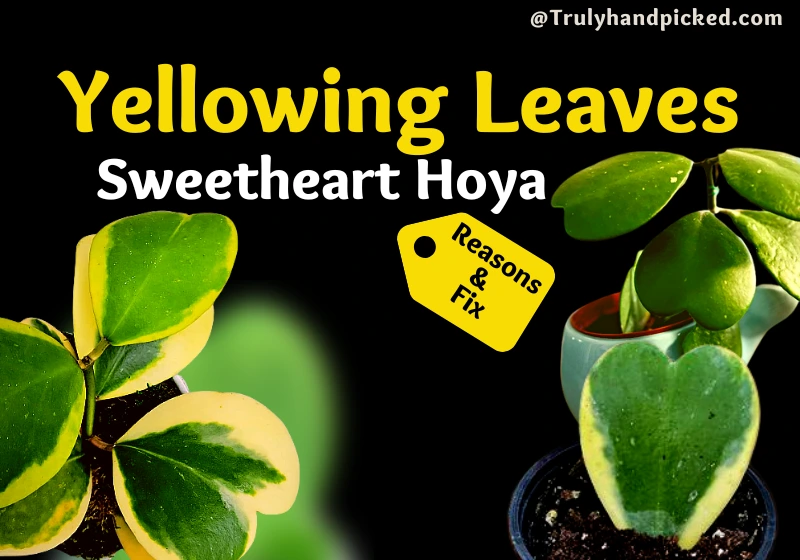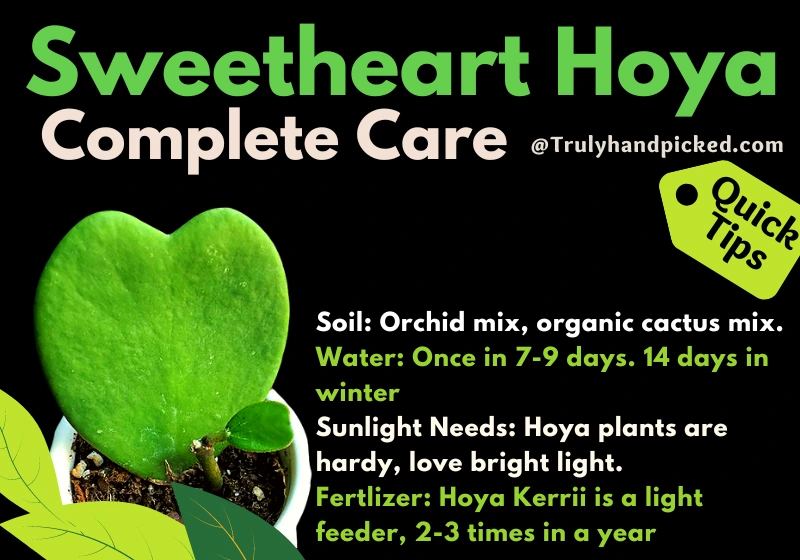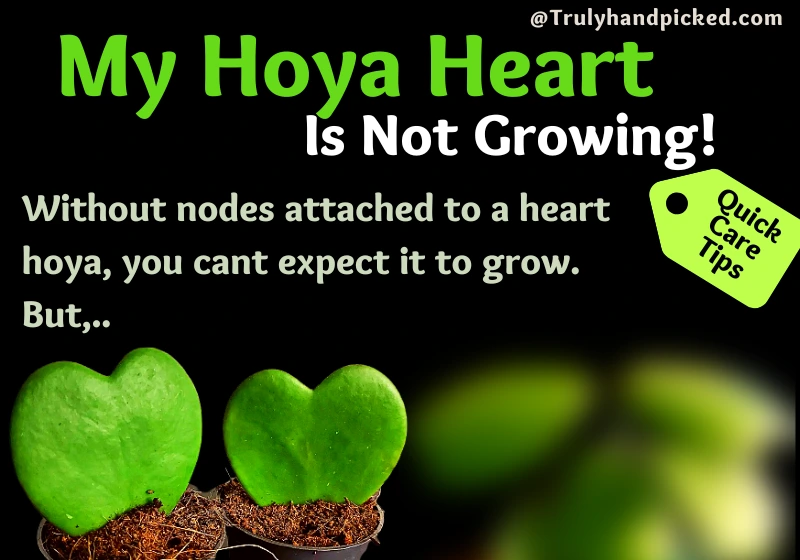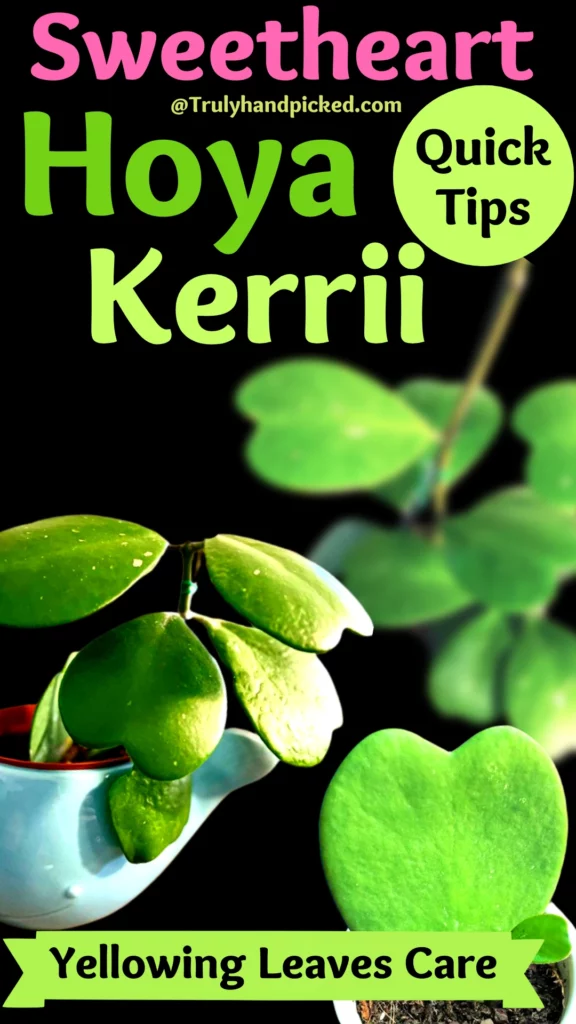Sweetheart hoya or hoya Kerrii is a highly noted succulent due to its exclusive heart-shaped texture. Native to southeast Asia, this plant could be a great indoor plant for its easy maintenance value.
The perfect heart shape of this tropical luscious vine brings many other interesting names to it, including the valentine plant.
Here are some must-know facts about a sweetheart hoya plant and its caring process, which we will discuss below in this attempt-

Why is Sweetheart Hoya Turning Yellow?
If you are clueless about why your growing sweetheart hoya is turning yellow without providing the entire growing needs, here is a quick review of this problem-
Reasons:
- Insufficient light, like too much direct light or too little sunlight. This may hamper the photosynthesis process of the plant and result in this yellow leaf
- Indecorous watering is like overwatering or underwatering or no watering at all. It leads to the improper oxygen supply and causes root rot, which invites yellow leaf problem
- Quality of the water, like when you use normal tap water instead of distilled or filtered water. This type of water often instigates some bacterial or fungal buildup into the soil and causes a loss of vigor in the leaf
- Incorrect temperature, like less than 60° F or more than 80° F. As, too high temperature can interrupt the malfunction process of the plant, while too cold climate can cause frost damage to the leaves of your plant
- Improper fertilization is like too much fertilization or no fertilization at all. Heavy or frequent fertilization may cause minerals or salt buildup in the soil, while less fertilization brings nutrient deficiency to your plant
- Untreated pests’ infestation, like letting some common pests of sweetheart hoya plant destroy the juicy leaves and stems perceptively. Pests and bugs like mites, mealybugs, scales, aphids, thrips, etc. suck the juice from saps and leaves, which often turn the healthy leaves yellow shortly
How to Fix:
- Place your hoya plant pot in an east or west-facing window with partial shade. This will provide your growing the right amount of light with a proper filter.
- Water your plant only when the top surface of the soil turns completely dry. Always use well-drained soil and plant your hoya in a planter that has a good drainage system. Try to reduce your watering with the changing seasons, as the water needs of this succulent vary with the different climates.
- Use distilled or filtered water every time you water your indoor sweetheart hoya plant. Normal tap water contains lots of bacteria, which cause unhealthy roots and interrupted nutrient production. Using distilled water will reduce this possibility effectively.
- Place your planter under bright but indirect light with a temperature between 65°-80° F. You can get help from any advanced tools like ventilation or cooling devices to make the temperature perfect artificially.
- Feed your plant with a balanced all-purpose fertilizer twice a month in a 2-1-2 NPK ratio. Never let your plant face nutrient deficiency with improper fertilization. You can use liquid or diluted plant foods to feed your growing hoya kerrii plant appropriately.
- Fertilization always varies with the planter size and light force. If your plant is growing in a larger planter, with high light intensity, you should feed your plant with a large amount of fertilizer than the usual quantity. Try to apply a fertilizer that is balanced with nitrogen, potassium, phosphorous, and magnesium for a better result.
- And never encourage the infestation of pests or bugs ever on your plant. Try to apply any possible home remedies to cure them instantly, once you detect any of them on your growing sweetheart hoya plant. You can apply the soapy water, rubbing alcohol, neem oil, etc. home remedies to treat such issues efferently.

Sweetheart Hoya Complete Care:
- Loose, airy, and well-drained soil type would be the best pick to sow a hoya plant
- Prepare a potting mix using an orchid mix, organic cactus mix, and perlite in an equal amount
- Water your plant once a week primarily, and use distilled water at normal temperature
- Let the soil dry a little between watering and reduce the intensity during winter
- So, you can water your plant once in 7-9 days in the normal season and 14-21 days during winter
- Make sure you keep the soil evenly moist with proper watering, without making it soggy
- These tropical hoya plants are hardy and thus, can stand bright light with high humidity
- Keep your planter in a warm spot where it can grab bright yet indirect light consistently
- Maintain the temperature between 60° to 85° F and never let the heat below 60° ever
- You can use a humidifier to keep the humidity level up to provide your plant with a tropical climate
- Hoya Kerrii is a light feeder, so, fertilize it twice or thrice a year with a balanced fertilizer
- You can use organic water-soluble liquid plant food to feed your growing hoya perfectly
- Prune your plant to keep the size in control and healthy as well, by removing dead parts
- Check on growing pets and bugs attack to cure them entirely in time, before your beautiful can get any harmful damages from such issues.

Is Sweetheart Hoya a Succulent?
Sweetheart Hoya is a tropical succulent vine as most garden experts know. Due to being a stifling succulent, this species of hoya is often grown and sold as leaf cuttings.
Sweetheart hoya belongs to the dogbane family, which is a parent succulent genus. Here are some statistics you should know about a Hoya Kerrii plant to recommend it as a succulent-
- Like other common succulents, sweetheart hoya also comes from the Apocynaceae genera
- Sweetheart hoya plants have latex sap
- It has a high fragrance and is rich in alkaloids compounds
- The top surface of leaves and flowers have a waxy layer
- And like other typical succulents, the flowers of Hoya kerrii also change their fragrances with their developing period or age.

Why is My Sweetheart Hoya Not Growing?
Sweetheart hoya or hoya Kerrii is a beautiful tabletop plant with a moderate growth rate. Some categories of sweetheart hoya have a slow-growing rate as well.
In short: If you have a store-bought single leaf hoya in a pot for valentines day, it won’t probably grow without a stem attached to it.
But, a single leaf hoya heart can live for years in the same small pot without any new shoots. Without nodes attached to a heart hoya, you cant expect it to grow.
But if you are looking for your normal hoy heart plant is not growing, check the following reasons and solutions to get it back to normal.
Any variety of hoya kerrii can thrive up to 10 inches long with 6-8 inches in width with proper care. But sometimes, you may find that your hoya plant is not growing expectedly or couldn’t thrive after propagation. This problem occurs due to some commons case, such as-
Reasons
- If you couldn’t provide the plant its required growing climate
- When you propagate a hoya kerrii leaf without any stem-part
- Your plant may suffer from nutrient deficiency through lack of fertilization
- If your plant gets bright but direct light or indirect but low-light
- When you move the planter often and give your plant sudden shocks
- If your plant is secretly suffering from root problems due to a watering issue
- Or couldn’t drain the excess water properly due to poor drainage quality
- When you provide your plant with low humidity that is lower than 50%-60%
- If you hoya plant it in an unnecessarily wide planter
- And when your plant is going dormant due to season changes.
How to Fix
To deal with these issues you must be attentive to the basic need of a newly planted or growing hoya kerrii plant. Try to follow these steps carefully in this attempt-
- Place the planter of your hoya plant in a warm and moderately sunny location with 60% or higher humidity
- Use complete airy soil with good drainage quality, amend with cactus or orchid mix
- Take a planter with enough drainage holes and water the plant only when the soil turns dry
- Always feed your plant during summer, spring, and fall, attentively to boost their growth
- Apply liquid fertilizer in diluted form to get the best thriving experience
- Stop moving your planter often don’t repot frequently, unless it is essential
- Use perfect sized planter that can keep the root-bound uninterrupted
- And wait till the dormant season is over, and new season arrives to see your favorite plant in its properly growing form again.
